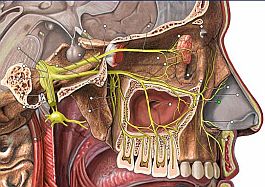 Nervus nasociliaris: es una de las tres ramas en que se divide el nervio oftálmico del trigémino (nasal, frontal y lagrimal). Es la más interna de las tres, atraviesa la hendidura esfenoidal por la parte interna del anillo de Zinn, gana la pared interna de la órbita y sigue por ella hasta el agujero orbitario interno anterior, en donde se bifurca.
Nervus nasociliaris: es una de las tres ramas en que se divide el nervio oftálmico del trigémino (nasal, frontal y lagrimal). Es la más interna de las tres, atraviesa la hendidura esfenoidal por la parte interna del anillo de Zinn, gana la pared interna de la órbita y sigue por ella hasta el agujero orbitario interno anterior, en donde se bifurca.
-Ramas colaterales. Son tres principales: la raíz sensitiva del ganglio oftálmico, filete largo y delgado; los nervios ciliares largos, que se juntan al grupo de los nervios ciliares salidos del ganglio oftálmico; el filete esfenoetmoidal de Luschka, que se introduce en el agujero orbitario interno y posterior y termina en la mucosa del seno esfenoidal.
-Ramas terminales. Son dos: 1.nasal externa, que se distribuye por la región interciliar, las vías lagrimales y la piel de la nariz; 2.nasal interna, que penetra en las fosas nasales y se distribuye en ellas por dos ramos, uno para el tabique y el otro para la pared externa de las fosas nasales y la piel de la nariz (nervio nasobulbar).
<(A.): Nervus nasociliaris: ist ein Ast des Nervus ophthalmicus. Er liegt in der Größe zwischen den beiden anderen Hauptästen des N. ophthalmicus, dem N. frontalis und dem N. lacrimalis, und ist tiefer gelegen. Er tritt in die Augenhöhle zwischen den beiden Köpfen der seitlichen Rektusmuskeln und zwischen den oberen und unteren Ästen des Nervus oculomotorius ein. Er überquert den N. opticus und verläuft schräg unter dem Musculus rectus superior und dem Musculus obliquus superior zur medialen Wand der Orbita. Nachdem er den Nervus ethmoidalis anterior abgegeben hat, endet er als Nervus infratrochlearis am medialen Rand der Orbita. Der Nervus nasociliaris gibt folgende Äste ab: Nervus ethmoidalis posterior; langer Ziliarnerv; Nervus infratrochlearis; Verbindungsast zum Ganglion ciliare (lange Wurzel des Ganglion ciliare): Nervus ethmoidalis anterior.
<(F.): Nerf nasal, nerf naso-ciliaire: prolongement du nerf ophtalmique, est situé dorsalement au nerf optique. Le nerf ophtalmique va se diviser en 3 petites branches sensitives. Le troisième, le nerf nasal, est un nerf qui va se diviser très vite en plusieurs branches : le nerf ethmoïdal antérieur, le nerf ethmoïdal postérieur, le nerf infratrochléaire, le nerf ethmoïdal antérieur donnera le nerf nasal externe (nerf naso-lobaire) qui donne le nerf infratrochléaire qui innervera la pointe du nez. Le nerf infratrochléaire innervera la partie médiale de la paupière supérieure (sensitif). Le nerf nasal va ensuite passer au dessus du ligament palpébral médial pour innerver le sac lacrymal et l'aile du nez.
<(In.): Nasociliary nerve: is a branch of the ophthalmic nerve. It is intermediate in size between the two other main branches of the ophthalmic nerve, the frontal nerve and the lacrimal nerve, and is more deeply placed. Enters the orbit between the two heads of the lateral rectus muscles and between the superior and inferior rami of the oculomotor nerve. It passes across the optic nerve and runs obliquely beneath the superior rectus muscle and superior oblique muscle to the medial wall of the orbital cavity. After giving the anterior ethmoidal nerve, it terminates as the infratrochlear nerve on the medial margin of the orbit. The nasociliary nerve gives off the following branches: posterior ethmoidal nerve; long ciliary nerves; infratrochlear nerve; communicating branch to the ciliary ganglion (long root of the ciliary ganglion): anterior ethmoidal nerve.
ANATOMÍA:
- ANATOMY OF THE HUMAN BODY. <(Ing)
FUENTES DE INFORMACIÓN BIOMÉDICA:
- GOOGLE ACADEMICO. <(E)
- GOOGLE SCHOLAR. <(Ing)
- NCBI: Entrez. <(Ing)
- PubMed. <(Ing)
TÉRMINOS RELACIONADOS:
